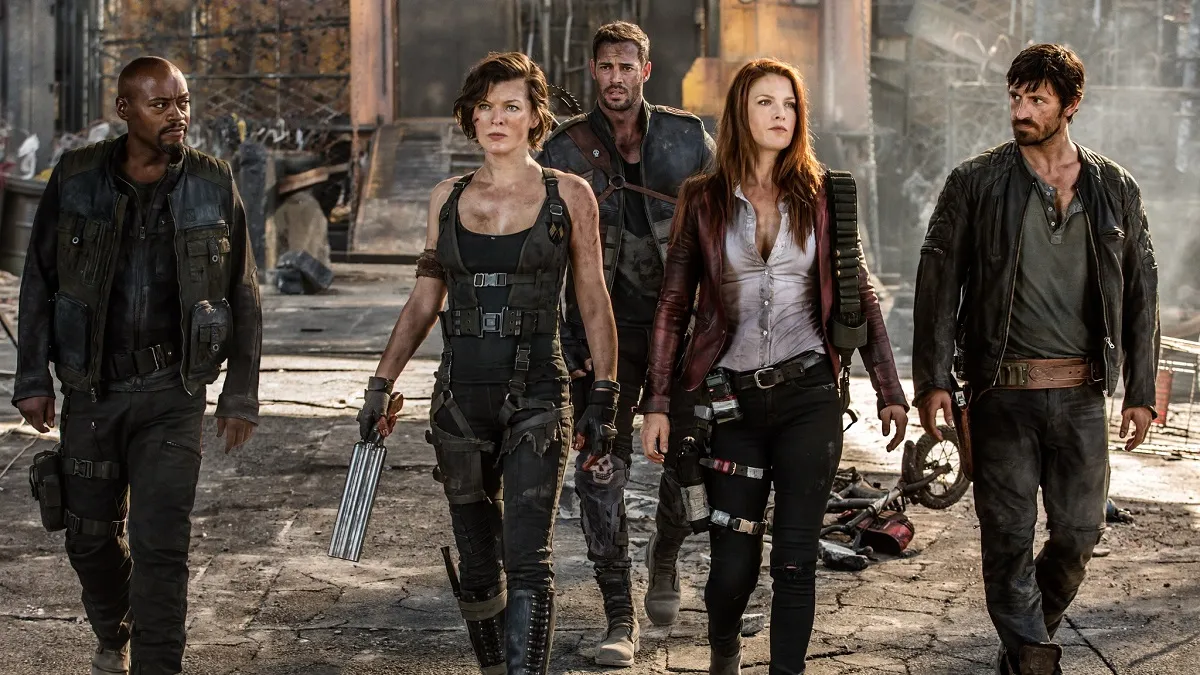A winner is you
Hello, starmen and starwomen, and welcome back to The 300, my successful attempt to see 300 movies in theaters in 2018. I’ve watched new releases, classics, hidden gems, and festival films to experience the wide world of cinema in all its forms. With so much moviegoing variety, I think there’s probably something I’ve seen that you’d also like. If not, that’s on you, jabroni.
As always, there are three rules for The 300:
- The movie must be at least 40 minutes long, meeting the Academy of Motion Picture Arts and Sciences’ definition of a feature film.
- I must watch the movie at a movie theater, screening room, or outdoor screening venue.
- While I can watch movies I’ve seen before 2018, I cannot count repeated viewings of the same film in 2018 multiple times.
The 300 started as a dumb joke. I figured I’d exploit the system and see as many movies as possible via MoviePass. The number 300 was nice and round, and it gave me wiggle room so I wouldn’t have to go to the movies every day. Thanks to the hyper masculine silliness of the Zack Snyder film, 300 also became a fun excuse to do the dumb photoshops that have accompanied these weekly recaps.
For example:

Without MoviePass, this wouldn’t have been possible. I have renewed my love of going to the movies thanks to a lot of misguided venture capital put into tech companies with terrible business models. Subscription services Like MoviePass and AMC A-List make regular moviegoing possible when it would otherwise be prohibitively expensive, but they are unsustainable. Smoke ‘em while you got ‘em. For instance, I think I’ve seen $3,600 worth of movies on MoviePass this year, and all I’ve paid is about $110. To Helios and Matheson shareholders, I’m sorry for playing by the rules as written.
Given MoviePass’ decline, the 300 also wouldn’t have been possible without my access to press screenings and my ability to attend and cover film festivals. In fact, a good chunk of The 300 is thanks to extensive viewing at the 2018 Tribeca Film Festival and the 2018 New York Film Festival. Part of me feels like this is a bit of a cheat, but I put in the time, and that’s something.
The total runtime of The 300 is 31,387 minutes. That’s 523.11 hours. That’s 21.79 days. Putting that all together, that’s 21 days, 19 hours, and 7 minutes worth of movies in theaters in 2018.
There’ll be a longer recap to come since I have lots of thoughts about a year of dedicated moviegoing, and ditto the intimate-yet-shared solitude of seeing good films with others. The year isn’t over, gang.
And so, here we are.
296 of 300: An Oversimplification of Her Beauty (2012)

Director: Terence Nance
Starring: Terence Nance, Namik Minter
Country: USA
Seen at BAM Rose Cinemas (Brooklyn, NY)
Wednesday, November 14th
An Oversimplification of Her Beauty feels like a semi-documentary partially-animated rom-com collage about unrequited love written by Italo Calvino and Michel Gondry. Terence Nance playfully cuts back and forth between a short film about a romantic relationship with his friend Namik Minter that never materialized, and a rumination on that relationship a few years after the fact. Nance also hops between fiction and non-fiction, and different animation styles, and different narrators for the voiceover.
It takes a moment to settle, but Nance captures the frustrated mindset of loving someone who just doesn’t love you back, and that unsavory thought process when you beat yourself up over it. We’ve all been on either side of that equation at some point of our lives, and it’s surprising (and mortifying) how well the movie recreates that recursive self-flagellation. What did I do wrong? Maybe something minor, or possibly nothing at all. People drawn to each other don’t always feel the same about the other person. Nance even mentions the obvious answer to his obsession: maybe she’s just not into you. Minter cares about him, likes him, is attracted to him, and yet. That unexpressed reservation may be inexpressible.
I mentioned the film as a mortifying experience, and that’s more true in the second half. At that point, An Oversimplification of Her Beauty feels like a public artistic spectacle of a tricky private relationship. While Nance is game to explore his hang-ups in public and make a spectacle of his neuroses, I wondered how Minter felt about her life being explored by someone else. It’s awkward seeing Nance pine for Minter on screen given how obtrusive his cinematic obsession feels; maybe that’s part of the inexpressible reservation. I’m not sure the whole comes together, but it’s a deeply felt art piece about one-sided romance and irresolvable feelings.
297 of 300: Widows (2018)

Director: Steve McQueen
Starring: Viola Davis, Michelle Rodriguez, Elizabeth Debicki, Cynthia Erivo
Country: UK/USA
Seen at AMC Loews 34th Street 14 (New York, NY)
Thursday, November 15th
It’s unfair to compare Widows to Ocean’s 8 (The 300 Week 23). There’s a heist in each film, sure, but they are so tonally different. Widows is less like Ocean’s and more like The Wire. Picture Steve McQueen’s version of a Michael Mann or Christopher Nolan thriller, with an edge sharpened by co-writer Gillian Flynn (Gone Girl). Widows is a high-minded crime drama that’s also an exploration of gender, race, class, political rhetoric, structural inequality, and violence. It’s one of the best-crafted movies of the year, with a stellar ensemble cast, and it’s currently slotted in my top 10 of 2018.
We begin with a heist gone horribly wrong (but blowed up real good). The widows of the dead thieves are brought together to pull off a big job. They don’t really have a choice; if they don’t take the job, they’re in debt, dead, or without options in life. The ladies essentially have to clean up after the men in their lives. Viola Davis is great as the no-nonsense ringleader, and Michelle Rodriguez is ever the reliable supporting player. Elizabeth Debicki and Cynthia Erivo are the two breakout performers of the ensemble. Debicki plays a woman no longer content being abused and acted upon, and Erivo is a moral force and a physical presence every time she’s on screen. Daniel Kaluuya is also great in the film as a political candidate’s ruthless, sociopathic enforcer, pure menace every time he’s on screen.
McQueen has always been great with long takes in his films, and there’s a standout single-shot sequence in Widows. Colin Farrell’s character is up for re-election in a South Side Chicago precinct, part of a local political dynasty. He courts the black vote in hopes it’ll give him an edge over his opponent. He leaves a photo opp in a depressed part of the South Side, gets into his car, and is driven a few minutes away to his home in an affluent neighborhood. All the while, he’s saying the sorts of two-faced things we suspect politicians say in private. The driver of this car is black, and just does his job while this exchange goes on, his blank face sometimes visible through the reflective, tinted windshield. In just a few minutes, we get the layout of this part of Chicago, a sense of the economic disparities from block to block, and experience the whiplash of private and public personas donned by politicians. Here’s the formal power of a single shot well-considered, properly deployed, and well-executed; a shot like the perfect crime.
Widows is masterful entertainment.
298 of 300: Voyage of Time (2016)

Director: Terrence Malick
Country: USA
Seen at BAM Howard Gilman Opera House (Brooklyn, NY)
Friday, November 16th
Calling a film a “tone poem” is like saying a short story is merely “interesting.” As George Saunders said, you want a story to be so much more, and for people to say your work is brilliant or moving or that they want to sleep with you. But “interesting”? “Interesting” is a polite admission of disinterest.
Terence Malick’s Voyage of Time is an interesting tone poem. We view the creation of Earth through its end with imagery that is gorgeous but too often familiar, and hokey, repetitive, pseudo-spiritual narration. Malick intercuts these pristine images of life evolving with grainy digital footage of the world we know today. While I understand the idea behind these present interruptions during an unfolding past, they seemed too jarring, though they take on a power by the end. I’ll also admit loving some of the more psychedelic imagery, whether of bacteria or prehistoric underwater life. The best single cut in the movie is so memorable: a single low-angle shot of wheat to signify the transition from hunter-gatherer societies to agrarian societies before transitioning to modern cityscapes. (Who needs the Industrial Revolution, right?)
The live musical accompaniment at the BAM opera house was phenomenal, though, and made the sort of tedious movie a fascinating experience. David OReilly’s game Everything is a much better realization of what Malick was trying to do with Voyage of Time.
299 of 300: Jason and the Argonauts (1963)

Director: Don Chaffey
Starring: Todd Armstrong, Nancy Kovack, Honor Blackman, Gary Raymond
Country: USA
Seen at Film Forum (New York, NY)
Saturday, November 17th
My love for movies can be traced back to my Uncle Mike. He used to live in our house for a while. I was maybe five or six years old. Every now and then he’d bust out a videotape of an old movie he loved and give me a curated journey through his cinematic obsessions. That’s how I was first introduced to the work of Ray Harryhausen, and ditto the original Planet of the Apes movies, Sinbad movies, the original Star Trek show and films, and so on. It’s odd to think that an entire life of movie watching might be defined by one person. It’s the same way that an older sibling’s music collection helps mold the taste of a younger sibling. My Uncle Mike was the first older brother I never had.
Jason and the Argonauts was one of the films he showed me. I’ve always been fond of the film even though I haven’t seen it since I was a child. It’s a wonderful old-timey adventure in the Sinbad mold, featuring some of Harryhausen’s most iconic work. The battle against the skeleton warriors is still phenomenally choreographed, which is surprising for such an old film. There’s genuine cause and effect as our Greek heroes, outnumbered and terrified, slash at the air and leap over the blades of these undead soldiers.
Watching it as an adult for the first time, I was struck by how unsubtly homoerotic the movie is. It was Ancient Greece, so it fits. Just watch that dynamic between Hercules and Hylas. They are totally into each other from the first second they meet. I wonder how this played in 1963.
While MoviePass made The 300 possible from a practical standpoint, the seeds were planted years ago while sitting in front of a tiny television watching VHS copies of movies made decades before I was born.
300 of 300: After Life (1998)
(aka ワンダフルライフ; Wandafuru Raifu)

Director: Hirokazu Kore-eda
Starring: Arata, Erika Oda
Country: Japan
Seen at The Film Society of Lincoln Center (New York, NY)
Monday, November 19th
Hirokazu Kore-eda’s After Life is such a wonderfully humane ugly-cry of a movie, and a fitting 300th film. After dying, you are told that your happiest memory will be recreated on film. This recreated memory will be the only thing you recall for the rest of eternity. The set-up is fantastical, but its exploration and concerns are so grounded. Purgatory is a municipal building, and the people who handle and process these cases are a mix of therapist and HR rep. After Life is all about the moments that make life worthwhile, and many of them are tiny, private, so achingly human.
This is formally unlike the other Kore-eda movies I’ve seen, and often feels more like a documentary rather than a narrative feature. The people playing the recently departed were mostly non-actors interviewed about their own lives. The interviews with the people are carried out with simplicity, and their unscripted responses make it seem like conversations with an older relative. The essence of these treasured memories is the specificity of detail—the flavor or smell of the world, a turn of phrase, a fine distinction in the quality of sensation. One person remembers the sun on his skin as an infant, but its warmth was soft; not the summer sun, but the autumn sun. A WWII veteran recalls intense hunger and how delicious rice could be with just a little salt. The fact that some of these interview subjects have passed away in real life adds a greater poignancy to their memories. In real life, they got to live some version of the film’s fictional process.
Amid this human beauty, After Life is also an oddly affecting workplace drama. As we learn about the people who interview and recreate these memories, we become attached to them. They question why they do their job, and why any of this matters, which seems like this larger commentary about the existential strife of social workers, counselors, and artists. What is their job but to listen and interpret. It’s a process of receptive empathy, coaxing out the hidden joys from a person’s life to remind them that life was worth living. Extended to the purpose of writers or filmmakers, maybe the point is to share and create joy for others, and part of that is revealing a fundamental interconnectedness between people, places, and things. Everything might matter, even just for a moment; what a joy to remember that wonderful instant of your own life, which is contingent on everything else going on in the world and the lives of others.
After Life invites the audience to ponder their own happiest memories, and consider the difficulties of picking just one, or if there is even one thing worth picking. There’s always at least one.
I cried a lot during this movie—I’m embarrassingly crying in a cafe as I type this out—but there’s one shot that got me in particular. There’s a screening room where the deceased assemble to watch their recreated memories. These people that we have come to know in the film sit in the dark facing the screen. Kore-eda situates the camera at the front of the screening room, as if they are facing us, the audience watching them. The movie screen is the membrane between our world and the cinematic world, real life and the afterlife, the present and the past, the self and the other.
We are together in the dark, sharing a memory.




